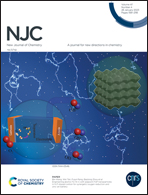A computational study on CO2 electrochemical reduction on two dimensional metal-1,2,3,4,5,6,7,8,9,10,11,12-perthiolated coronene frameworks†
Abstract
The electrochemical CO2 reduction reaction (CO2RR) is a valid strategy for the conversion of CO2 into valuable fuels and chemical products, thereby alleviating the energy crisis and environmental problems. In this work, the reaction mechanism of the CO2RR has been studied on the two dimensional MOFs TM–PTC (TM = Sc–Zn, Y–Mo, and Ru–Ag; PTC = 1,2,3,4,5,6,7,8,9,10,11,12-perthiolated coronene) by using the density functional method. Our results showed that for the studied catalysts, the main products are CH4 and HCOOH. Mo–PTC has the best catalytic activity for the CO2RR in producing CH4. Axial oxygen modified TM–PTC, i.e., TM–O–PTC shows different catalytic behavior compared with those without axial oxygen in producing CH4. The inactive catalyst Nb–PTC for CH4 becomes active after modification with an axial oxygen ligand. Zn–PTC and Mn–PTC are the promising catalysts for the CO2RR in producing HCOOH. The solvent effect plays an important role in both the reaction mechanism and catalytic activity. We hope that this work can provide a new avenue for the development of 2D MOF type CO2RR electrocatalysts.



 Please wait while we load your content...
Please wait while we load your content...